How to clean a leather jacket at home?

A leather jacket is durable and practical. It is warm in it, it perfectly protects from the wind, and with the modern abundance of models and styles, even the most fastidious buyer can choose the option exactly to your taste. The only thing we rarely think about when purchasing a new thing is the need to regularly take care of it in the future and clean it in a timely manner, preventing stains of various origins from ruining the appearance of the product forever.

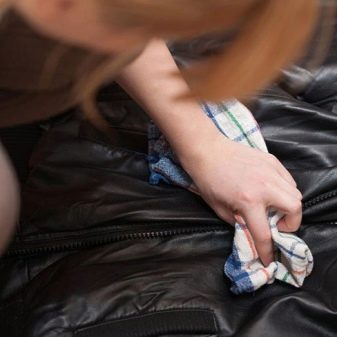
Peculiarities
Genuine leather is extremely sensitive to contact with any substance, whether it be plain water or an artificial chemical compound. The fact is that leather products owe their beauty to the animal fats contained in them, and the washing out of these fats negatively, and sometimes even fatally, affects their appearance. And it is unlikely that it will be possible to return aesthetics to things - at best, genuine leather will lose its softness and luster, and at worst, it will begin to crack and stretch.
Leather substitutes, which are also impregnated with oils, albeit of lower quality, often lose their color after improper cleaning.
That is why it is not recommended to use aggressive substances for cleaning at home.It is advisable to get rid of stains immediately after they appear, so that they do not have time to eat.
Processing a leather jacket is recommended not entirely, but only directly in places of pollution. And one more rule for leather things - you need to clean them using any cleaning products only in case of emergency, do it regularly, for “prevention” it is unacceptable.
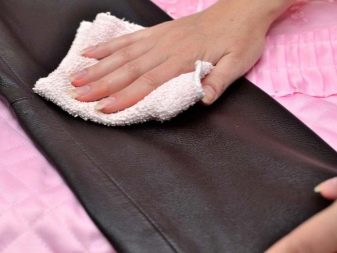

Types of pollution
As with any other clothing, dust particles settle on a leather jacket, raindrops and slush splashes leave traces. These are light contaminants, which do not require much effort and expensive means to remove. The same applies to traces of ordinary chalk, which are also quite easy to wipe off.
It is a little more difficult to remove “salt” stains, stains from paint or ink, scuffs, but there are proven remedies here. Often, greasy marks are found on a leather jacket, which are more difficult to remove, the greater their “age”.
Another problem is blood stains, both fresh and absorbed. But most of all, the collars, cuffs, the fastener and the top of the pockets deliver the hassle. The fact is that it is these problem areas that come into direct contact with human skin, which, as you know, sweat.
Constant contact with it, leather products are greasy, their surface darkens and acquires an unnatural sheen. But even this type of pollution can be dealt with. The main thing is not to run problem areas and clean them properly.


So, let's see what are the ways to clean a leather jacket with high quality and without much effort:
- Simple pollution, remaining daily on the surface of a leather jacket, such as traces of dust, raindrops or chalk, are easily removed with plain water. Moisten a small piece of cloth with warm water and simply wipe the skin. Carry out this procedure at least once a month. In no case do not put on the jacket immediately after cleaning, as wearing it in a wet or damp state will inevitably lead to deformation and damage to the material. Instead, hang the item on a coat hanger and dry completely.
Avoid using commercial wet wipes for daily cleaning of leather goods. The fact is that alcohol is almost always included in their composition, which, with frequent exposure, degreases the skin.


- If you notice that in some places on the jacket formed abrasions, use the help of ordinary glycerin, which you can buy at a pharmacy. Take a cotton swab, soak it in glycerin and gently work over all frayed areas. If the jacket is dark in color (for example, brown or black), you can not spend money on glycerin - it will be successfully replaced by an orange peel.
- If the jacket is damaged from paint, You can use any nail polish remover. The main thing is that among its ingredients there should be no acetone. Take a piece of a sponge or a small cosmetic sponge and, after wetting it with a little preparation, begin to erase paint stains with a little effort. There is an important nuance here - you need to remove the paint from the edges of the stain to its center. If you do the opposite, the skin will get stained, and cleansing will take longer.
It washes off paint and ordinary vegetable oil well, but it is not advisable to use it on the skin, because then you will also have to remove the resulting greasy stain.

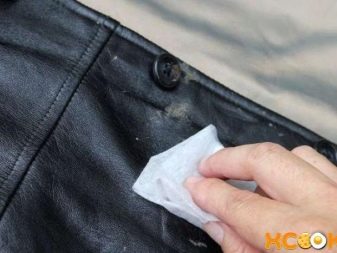
- Fresh traces of fat completely disappear if treated with any quality dishwashing detergent. Just moisten a cloth with it and blot the problem area - the fat will be removed. This is a completely safe method, but it is unlikely to help if the stain has been planted for a long time. In this case, you can use a choice of: white spirit, a mixture of ammonia and soap solution, or mixed acetone and alcohol. Just soak a cotton pad and dab on the stain. Here, the substances already used are not so harmless, therefore, whatever you choose, be sure to test the product on a small invisible area of \u200b\u200bthe skin before applying.
- ink traces - also not a sentence for leather products. There are two good ways to remove them as well. The first is suitable if you have something to temporarily replace a damaged jacket. Take ordinary salt, pour it liberally on the stain. Lightly soak the salt on top with water. It needs to be slightly moistened so that it becomes moist, and not raw. Now you need to let the salt act on the greasy stain for two days, after which it can simply be shaken off, and the place where the ink was rubbed to a shine with a sponge dipped in turpentine.
The second way is much faster and easier. Take warm milk and use cotton wool to wipe the ink stain with it. Milk is excellent at removing these types of contaminants. All that is required after this is to wipe the skin dry with a clean cloth.

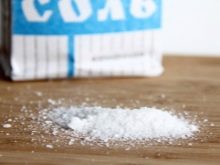

- If a leather jacket needs to be wiped blood stain, the method of cleaning will depend on the time of its appearance.If you just got dirty, you can use a mixture of water and liquid soap. Pour them into one container, mix and froth a little. After that, soak in the resulting solution and wring out the sponge well. With a damp sponge, gently blot, but do not rub the problem area. Friction can have the opposite effect - the blood will only be absorbed deeper into the skin, and the spot will increase in size. After completely washing off the blood, remove the remnants of the soapy solution with a damp cloth.
- old blood stains leather jackets can be removed with hydrogen peroxide. Moisten a piece of soft terry cloth a little and apply a few drops of peroxide to it. Then blot the place where the blood has eaten in with a patch, but do not rub. Now we need to wait for the chemical reaction. Contacting with blood, hydrogen peroxide decomposes, forming oxygen and water. That is why, when treating a wound, we observe the formation of many small bubbles. Exactly the same should appear on the material of the jacket - they will bring blood particles to its surface, after which you can simply wipe them off with a dry terry cloth.
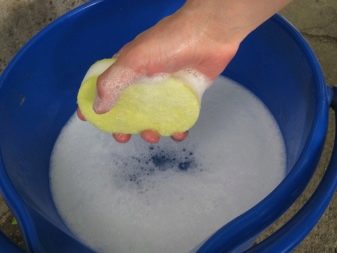
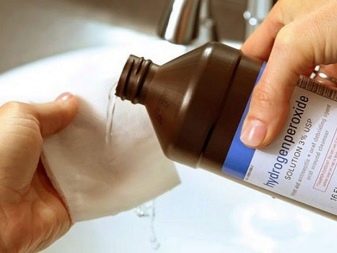
- Strongly greasy places we process in the following order: first with medical alcohol, then with lemon juice, and at the end, to restore softness to the skin, with glycerin. For processing, you can use a sponge or cotton pads. Another way, more gentle, rubbing milk to remove makeup.
If there is mold, a handle on the material, or you need to get rid of greasy, then use one of these methods.
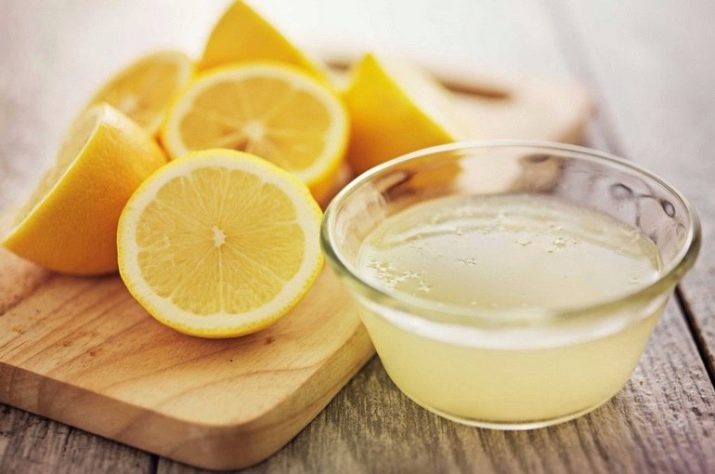
What can be washed?
Sometimes a leather jacket gets so dirty that it needs to be washed entirely.The choice of means for this directly depends on the type of pollution, as well as the thickness and strength of the material, because the skin of different animals, as well as different leather substitutes, vary greatly in these indicators. A soap solution is suitable for washing thin leather, and if you wash a jacket in an automatic machine, then only a special liquid agent for leather products. If the skin is thick enough, then you can take regular washing powder, but its amount should be halved.
Light skin should be cleaned very carefully. Removing stains from eco-leather with fur is not so difficult. Even red ink from a ballpoint pen can be removed.


Ways
Things made of leatherette and the lining of the house can be cleaned quite well. Most people think that a leather jacket can only be washed by hand. And the manufacturers themselves warn that machine washing is contraindicated for such things. However, many housewives who did wash their leather jackets in an automatic machine got excellent results. Perhaps the whole point is not in the very fact of using a washing machine, but in how to do it. Let's look at both methods - manual and machine.

In the washing machine
Before washing a leather jacket, it's a good idea to check how that particular material generally reacts to water. To get started, simply dampen a clean white cloth, wring it out well, and gently rub the leather over a hidden area. If even after such light manipulations the fabric changes shade, it means that the product cannot be washed either in a typewriter or by hand.
If the skin has passed this test, proceed to the next step of the test - take a spare patch sewn on the wrong side of the jacket and wash it as you are going to wash the jacket itself. If the patch has sat down, wrinkled or deformed, discard this cleaning method and wash the item by hand with more gentle means.
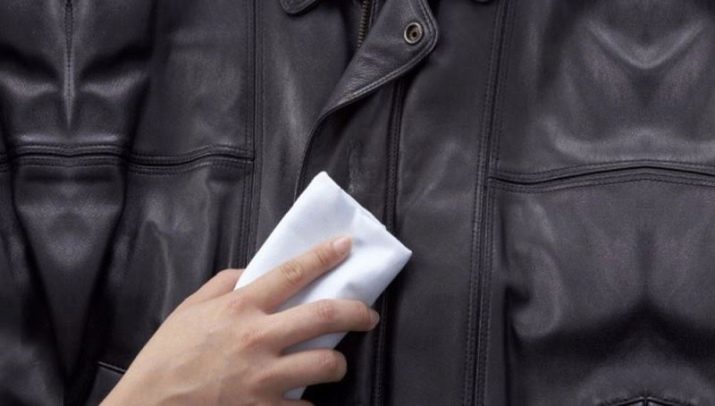
So, the material of your jacket reacted normally to the water and the selected detergent in the automatic machine. So, you can start the process itself:
- Be sure to fasten all existing rivets, zippers and buttons.
- Turn the thing itself inside out - this way you will prevent contact of the metal drum with the leather surface, which will help to avoid damage to it.
- Washing a leather jacket with a couple of soft clothes of the same color as it will also help reduce the aggressive effect on the skin.
- Set the gentle cycle using cold water and the shortest wash time without spinning.


Manually
If the labels of a leather jacket explicitly state that it can only be washed by hand, you should not go against this recommendation. In fact, this process is not so laborious:
- Pour warm water into a suitable size container and dilute a quarter cup of 9% vinegar in it.
- Add the selected detergent there with the calculation of a tablespoon of detergent per liter of water. This can be liquid soap, a special product for washing leather goods, or ordinary dishwashing liquid.
- Place the jacket in a container of water.
- Take a sponge and put on it a little of the product that you added to the water.
- With light movements without strong pressure, wipe the entire leather surface of the jacket.
- When finished washing, remove the jacket, wring out excess water without twisting, wrap the item in a terry towel for additional water absorption.
- After five minutes, straighten the washed jacket on soft hangers as best as possible and hang to dry in this form.


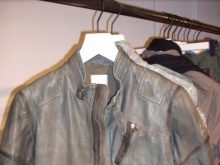
Tips & Tricks
Since leather is an unpredictable material, when cleaning it from dirt and stains, and even more so when washing There are a few important things to keep in mind:
- it is impossible to categorically wash two or more different leather items at the same time, even if they are of the same color, but if one item consists of several parts, they must be washed together;
- so that the multi-colored parts of the jacket do not turn into unnatural shades, during washing, you need to add a small amount of color fixing agent;
- keep in mind that if there are damaged or frayed spots on the jacket, after washing they will become even more noticeable;
- never use a washing machine to wring and dry a leather jacket;
- it is recommended to rinse leather products in water with a small amount of glycerin dissolved in it;
- small defects on the skin that appear after washing in a washing machine can be made less noticeable by painting the problem areas with an appropriate color aerosol nitro paint;

- the smell of washing powder from a washed item can be eliminated by wiping it with pieces of orange peel;
- if there are white stains on the jacket from the used laundry detergent, remove them with fresh lemon juice;
- to make the thing look like new again, immediately after washing, wipe the surface of the skin with castor oil and glycerin, and lemon juice will help restore its lost shine.


Drying and ironing of leather products, in particular leather jackets, also require no less attention. It should be dried either in an upright position, hung on a soft coat hanger, or laid out on a smooth, even surface with the sleeves fully extended. If there are any decorative elements on the jacket, additionally lay down a soft, well-absorbent towel.
Do not dry your skin with heaters, but, on the contrary, try to place it as far as possible from devices that emit heat. Of course, this way the thing will dry much longer, but it will definitely retain its beauty and aesthetics.
Leather jackets should only be ironed from the inside out. In this case, the temperature of the soleplate of the iron should be as low as possible.
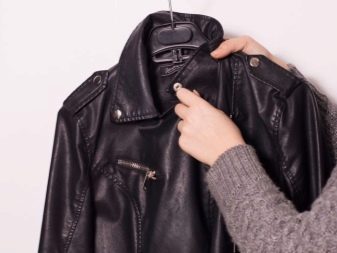

remember, that frequent washing spoils the appearance of products over time even from the highest quality and resistant leather. Therefore, it is better to take care of a leather jacket daily with minimal effort than to subject it to such a test every month.
Here are some simple tips for caring for and wearing leather items:
- Keep them away from heat sources.
- If you get caught in the rain or snow, do not rush to put your leather jacket in the closet. Remove the belt and all the contents of the pockets from it, as wet skin is easily deformed. After that, place the clothes on hangers and hang them freely to dry.
- Don't wait for dirt or hard-to-remove liquid to be absorbed into the surface of the skin, clean the item of dirt as soon as you notice it.
- To protect the skin from dirt and give it extra shine, an ordinary colorless shoe polish will help. It improves the appearance of a leather jacket by softening the material and visually smoothing out ugly creases.
- If you are going to hang a leather jacket in the closet until next season, do not be too lazy to clean it “for prevention”.
- To store leather outerwear, use special "breathable" covers.


Here are the basic guidelines for cleaning a leather jacket at home.
For more tips and tricks on how to clean a leather jacket, see the following video.




























